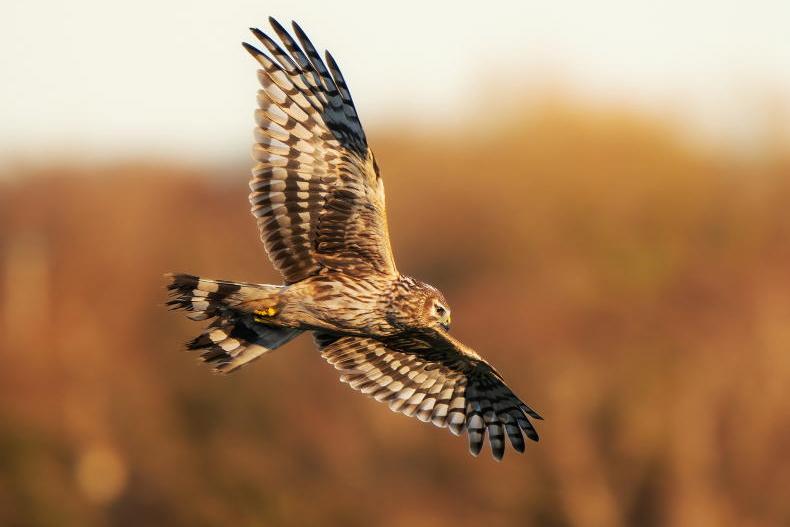More than 1,600 farmers across six special protection areas (SPAs) engaged in conservation-focused practices that enhanced the habitat for the hen harrier and other key species.
This comes from the final report of the Hen Harrier Project European Innovation Partnership (EIP), which operated between 2017 and 2023.
Over the course of the programme, a total of €20m in habitat and supporting action payments were made to farmers, with an additional €3.5m allocated to community actions, field trials of new actions, monitoring and project administration.
Project manager of the Hen Harrier Project Ltd Fergal Monaghan said that this demonstrates that when farmers are properly supported and incentivised, they can deliver meaningful conservation outcomes.
“By placing farmers at the centre of the programme and rewarding them for measurable improvements, we have developed a model that benefits both nature and rural communities,” he said.
“We hope that the lessons from this initiative will shape future policies and funding mechanisms for biodiversity and land management.”
Actions
The programme, funded with €23.59m under the Common Agricultural Policy (CAP), was the largest EIP in Europe at the time.
One of the features of the programme was the hen harrier bonus, which incentivised habitat improvements and successful breeding of the hen harrier.
This results-driven approach demonstrated that conservation and farming could work hand in hand, providing a viable model for future agri-environment schemes, according to the report.
Hen harrier project farmer Ruairi Costello from Slieve Aughties, Co Clare, said that the project was a great way to generate an income while doing some good.
"The hen harrier project was a brilliant initiative to be part of...when we came out of the REPS scheme there wasn't really an opportunity to do something with our designated SPA land,” he said.
“Farmers in SPA Lands relied on those hen harrier project payments and the local economy is suffering as a result. As it was a locally led scheme, the farmers knew the project officers, they knew the land themselves, and they got on well together...everyone worked together.”
Achievements
The final report said that over 46,000 hectares of land was managed to enhance biodiversity during the project.
In addition, over 4,000 conservation actions were implemented, including fencing, water infrastructure and habitat improvements.
The project noted a measurable increase in habitat quality, benefiting not just hen harriers but a wide range of wildlife.
Read more
New map shows land suitability for forestry
The long shadow of land designation
Slieve Bloom first nature project under new Coillte-NPWS collaboration
Commonage scores reflect farmers' commitment to habitats - ACRES CP team
More than 1,600 farmers across six special protection areas (SPAs) engaged in conservation-focused practices that enhanced the habitat for the hen harrier and other key species.
This comes from the final report of the Hen Harrier Project European Innovation Partnership (EIP), which operated between 2017 and 2023.
Over the course of the programme, a total of €20m in habitat and supporting action payments were made to farmers, with an additional €3.5m allocated to community actions, field trials of new actions, monitoring and project administration.
Project manager of the Hen Harrier Project Ltd Fergal Monaghan said that this demonstrates that when farmers are properly supported and incentivised, they can deliver meaningful conservation outcomes.
“By placing farmers at the centre of the programme and rewarding them for measurable improvements, we have developed a model that benefits both nature and rural communities,” he said.
“We hope that the lessons from this initiative will shape future policies and funding mechanisms for biodiversity and land management.”
Actions
The programme, funded with €23.59m under the Common Agricultural Policy (CAP), was the largest EIP in Europe at the time.
One of the features of the programme was the hen harrier bonus, which incentivised habitat improvements and successful breeding of the hen harrier.
This results-driven approach demonstrated that conservation and farming could work hand in hand, providing a viable model for future agri-environment schemes, according to the report.
Hen harrier project farmer Ruairi Costello from Slieve Aughties, Co Clare, said that the project was a great way to generate an income while doing some good.
"The hen harrier project was a brilliant initiative to be part of...when we came out of the REPS scheme there wasn't really an opportunity to do something with our designated SPA land,” he said.
“Farmers in SPA Lands relied on those hen harrier project payments and the local economy is suffering as a result. As it was a locally led scheme, the farmers knew the project officers, they knew the land themselves, and they got on well together...everyone worked together.”
Achievements
The final report said that over 46,000 hectares of land was managed to enhance biodiversity during the project.
In addition, over 4,000 conservation actions were implemented, including fencing, water infrastructure and habitat improvements.
The project noted a measurable increase in habitat quality, benefiting not just hen harriers but a wide range of wildlife.
Read more
New map shows land suitability for forestry
The long shadow of land designation
Slieve Bloom first nature project under new Coillte-NPWS collaboration
Commonage scores reflect farmers' commitment to habitats - ACRES CP team







 This is a subscriber-only article
This is a subscriber-only article










SHARING OPTIONS: